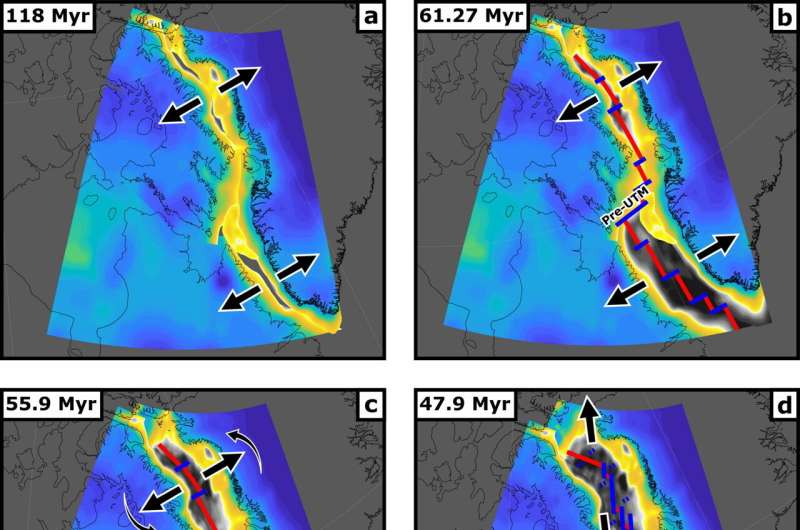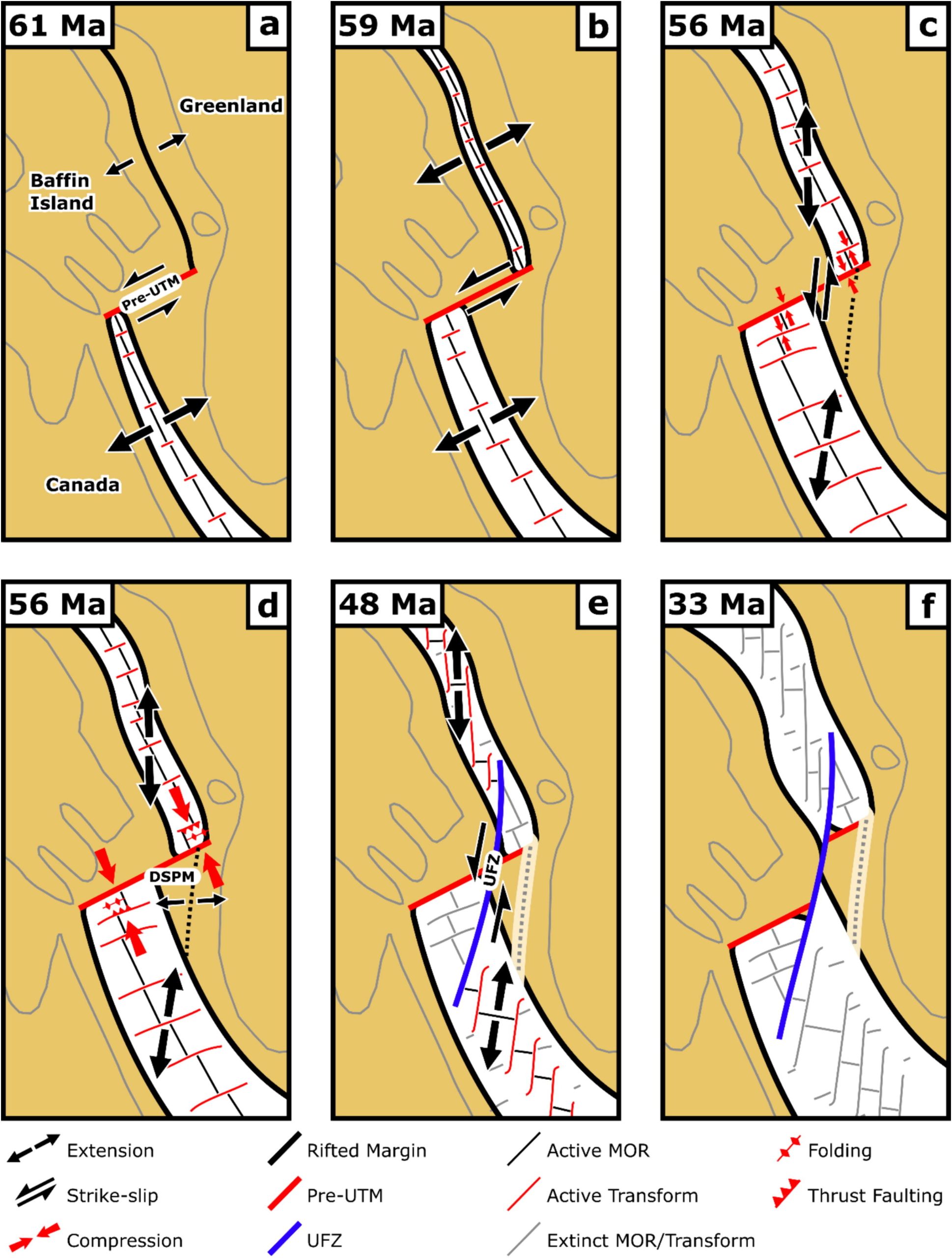
Schematic representation of the evolution of the Labrador Sea, Baffin Bay and Davis Strait through the Paleogene. Abbreviations: Pre-Ungava Transform Margin (Pre-UTM), Davis Strait proto-microcontinent (DSPM), Ungava Fracture Zone (UFZ). Credit: Longley et al. 2024.
Plate tectonics is the driving force behind Earth’s continental configurations, with the lithosphere (oceanic and continental crust and upper mantle) moving due to convective processes occurring in the softer underlying asthenospheric mantle. Many earthquakes, volcanic eruptions, and mountain formations are direct results of the movements of these globe-spanning plates, particularly at their edges.
One such plate boundary exists between Canada and Greenland, which has formed the Davis Strait seaway that connects two ocean basins, the Labrador Sea and Baffin Bay. The tectonic evolution of Davis Strait is dated to ~33–61 million years ago (Ma) during the Paleogene, during which a particularly unusual feature was formed: a thicker than normal (19–24 km) fragment of continental crust in the ocean.
This is now regarded as a newly recognized, incompletely rifted and submerged microcontinent off the coast of West Greenland: the Davis Strait proto-microcontinent.
Understanding the mechanism and reason for this crustal abnormality is the focus of new research published in Gondwana research. Doctoral researcher Luke Longley and Dr. Jordan Phethean (University of Derby, UK) together with Dr. Christian Schiffer (Uppsala University, Sweden) have reconstructed the plate tectonic movements that spanned a period of ~30 million years and resulted in the formation of the proto-microcontinent. They define proto-microcontinents as “regions of relatively thick continental lithosphere separated from large continents by a zone of thinner continental lithosphere.”
Dr Phethean explains why this particular location is so important for this research and why looking at the formation of microcontinents in the past is vital for today. “The well-defined changes in plate motion that occur in the Labrador Sea and Baffin Bay, which have relatively limited external complications, make this area an ideal natural laboratory for studying the formation of microcontinents.
“Rifting and microcontinent formation are absolutely ongoing phenomena – with every earthquake we are potentially working towards the next microcontinent rift. The goal of our work is to understand their formation well enough to be able to predict that future evolution.”

Model of plate tectonic evolution between Canada and Greenland, identifying the position of the Davis Strait protomicrocontinent (DSPM), and indicating the location of transform faults along the Mid-Atlantic Ridge and continental crust thicknesses. Credit: Longley et al. 2024.
To investigate this further, the research team used maps derived from gravity and seismic reflection data to identify the orientation and age of faults associated with rifting, the mid-ocean ridge (where Greenland tore off the North American plate) and associated transform faults (where two tectonic plates slide past each other).
The scientists determined that the first rift between Canada and Greenland began about 118 million years ago, during the Early Cretaceous, with seafloor spreading beginning in the Labrador Sea and Baffin Bay around 61 million years ago.
Subsequently, the period ~49–58 Ma is considered key to the formation of this proto-microcontinent, during which the orientation of seafloor spreading between Canada and Greenland changed from northeast-southwest along the Pre-Ungava Transform Margin, to north-south, separating the proto-microcontinent Davis Straight. Around ~33 Ma, ocean spreading ceased when Greenland collided with Ellesmere Island, after which Greenland joined the North American plate.
In this model, the Davis Strait proto-microcontinent is identified based on crustal thickness, with the microcontinent occurring in the range of 19 to 24 km thick, thinned continental crust, surrounded by two narrow bands of thin (15 to 17 km) continental crust that separate it from mainland Greenland and Baffin Island.
This research is applicable to other microcontinents worldwide to understand their erosion of continental crust, including the Jan Mayen microcontinent northeast of Iceland, the East Tasman Ridge southeast of Tasmania, and the Gulden Draak Knoll, offshore Western Australia.
Dr Phethean notes: “Better knowledge of how these microcontinents form will allow researchers to understand how plate tectonics work on Earth, with useful implications for mitigating plate tectonic hazards and discovering new resources.”
More information:
Luke Longley et al, The Davis Strait proto-microcontinent: the role of plate tectonic reorganization in continental rifting, Gondwana research (2024). DOI: 10.1016/j.gr.2024.05.001
© 2024 Science X Network
Quote: New incompletely rifted microcontinent identified between Greenland and Canada (2024, July 10) Retrieved July 10, 2024, from https://phys.org/news/2024-07-incompletely-rifted-microcontinent-greenland-canada.html
This document is subject to copyright. Except for fair dealing for private study or research, no part may be reproduced without written permission. The contents are supplied for information purposes only.
